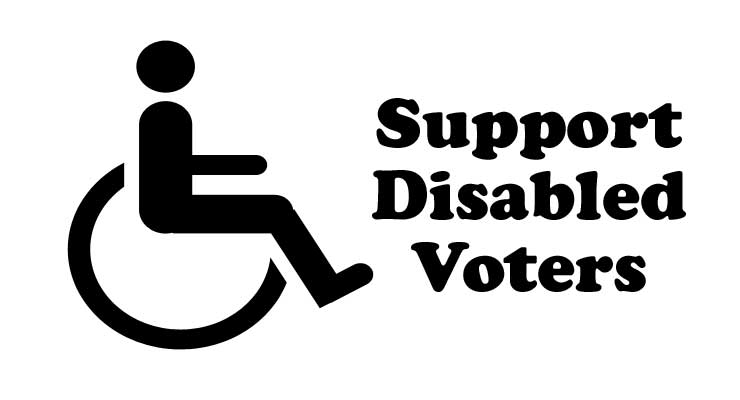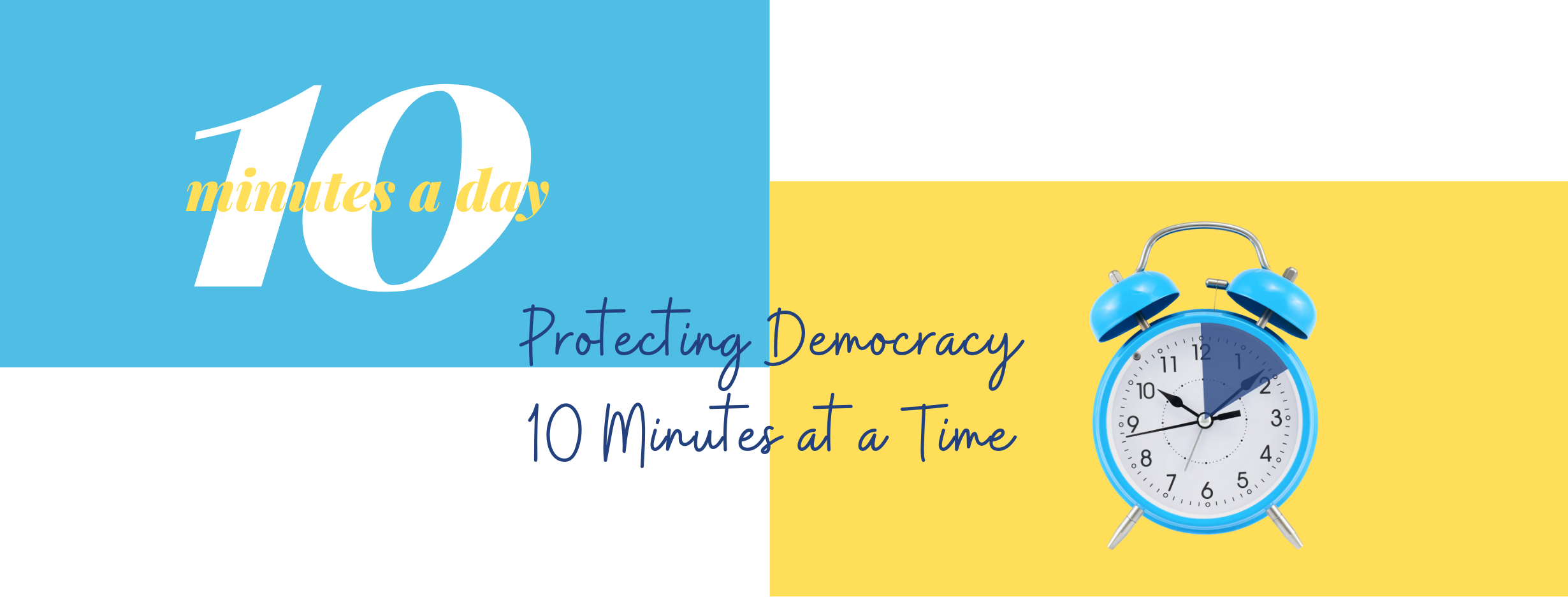
Americans with Disabilities
When we started 10 Minutes a Day, one of the most important goals we had was to support and fight for disenfranchised communities. According to the CDC, 61 million American adults have a disability, which is 26% of the population. People with disabilities have often been overlooked in policymaking, and disabled Americans may have difficulty mobilizing by virtue of our conditions.
Here's where we come in: Our organization is run by members of traditionally oppressed classes, and it's important to us to make sure that our country includes all of us. While many people have fought hard for working Americans, it's important to also give a voice to the disabled community. Our directors are part of this community and want to help.
What can we/you do? We are committed to advocating for people with disabilities, whether it's fighting for important social services, or increasing access to allow everyone to vote and have a voice in leadership and policy. To that end, we spotlight issues concerning people with disabilities and ways to be a strong advocate for the community, and we offer resources to help make sure that anyone who wants to can take part in voting, improving accessibility, providing support, and shaping policy.
Raising Awareness:
Often, a big part of disability rights advocacy involves trying to understand how disabilities affect people. In many cases, disabled people have an "invisible illness"--something that you can't see, but that doesn't mean they aren't disabled. This is important to know because when we presume that someone is able-bodied, we may unintentionally discriminate against them or limit their opportunities. Many chronic pain patients, for example, have been told they don't "look disabled." There is no one way a disabled person "looks" or "acts," and this is a harmful stereotype. People with disabilities have been treated badly at times because their non-disabled counterparts cannot "see" their conditions.
There are many ways we can raise awareness of how disabilities impact different people, which can be incredibly positive and life-changing to support disabled people. Here are some tools to increase awareness:
Spoon Theory (#Spoonie, #Spoonies): One woman with a chronic condition has an excellent explanation for what it means when non-disabled people tell those with disabilities that "you don't look sick." She calls it spoon theory, and reading about this and sharing it can help provide support to those people with long-term disabilities who don't "look" or "act" as some presume a disabled person "should."
Ableist Language: Sometimes, people use words that they may not realize can be ableist and perpetuate harmful stereotypes about people with disabilities. One great way to address that is to help people learn about what type of language may be ableist and alternatives they can use. Here is a link about what terms may be ableist, with non-ableist alternatives and explanations for what the issue may be.
"Special Needs?": Many disabled people and disability rights advocates have tried to explain why the term "special needs" can be a problem. One woman, Michelle Swan, explains that "my needs are not special."
Another organization explains that "People with Down syndrome [and other disabled people], like everyone else, have basic human needs – to eat, drink, breathe and sleep – to be nurtured, loved, educated and sheltered – to move, communicate, contribute and work – and to share, love and live. Sure, people with Down syndrome may need extra assistance. Sometimes they even need significant assistance, and adjustments, to meet a particular need. But that doesn't make that common human need 'special.'" This group encourages people to use #NOTSpecialNeeds on social media to raise awareness.
In 2016, the Cognitive Research Journal studied how people perceive and react to the phrase "special needs." They found that people "are viewed more negatively when described as having special needs than when described as having a disability or having a certain disability. ...We also...found that special needs is associated with more negativity; special needs conjures up more associations with developmental disabilities (such as intellectual disability) whereas disability is associated with a more inclusive set of disabilities; and special needs evokes more unanswered questions. These findings recommend against using the euphemism special needs."
Let's help raise awareness and support people with disablities by using alternate language and amplifying #NOTSpecialNeeds.
Policies:
Disabled people have been largely ignored and/or overlooked by our elected officials. This is despite the fact that people with disabilities make up about 26% of the electorate in the US, or about 61 million adults with disabilities, according to the CDC. We should use our numbers to make sure we are included in policy decisions. However, by virtue of our disabilities, it can be difficult for our community to mobilize. That's why 10 Minutes A Day is tracking efforts made by politicians to include people with disabilities in leadership and in the policies they enact.
There are a number of ways to support the disabled community by being aware of some good (and bad) policies and bills that are out there and that greatly impact people with disabilities. Here are some of them:
The CAPABILITY Act (HR 3070): Americans with developmental or intellectual disabilities face discrimination in the workplace. The CAPABILITY Act would create grants and programs to create more jobs for this community. Only 21% of young Americans with developmental/intellectual disabilities are employed, and this bill would help to change that. The National Down Syndrome Society has a script, and you can send your message to ask your elected officials to support the CAPABILITY Act by filling out a simple form here.
The Disability Integration Act (DIA, HR 555): In 2019, a bipartisan bill was introduced to provide people with disabilities the support they deserve and community-based resources to offer an alternative to going to a long-term care facility. To learn about that bill, go here. Want your elected officials to co-sponsor and pass the DIA? Visit this link for a script to contact your members of Congress and support this bill.
The IDEA Act: The IDEA Act was passed in 1990 and reauthorized in 2004 and 2015. According to the Department of Education, the IDEA Act was enacted to ensure that children with disabilities receive a free and quality public education with access to the accommodations/resources they need to have their needs met. There are six parts to the IDEA Act, which include protecting the rights of disabled children and their parents/guardians, early childhood intervention for disabled children and their families, ensuring that educators have the tools to provide a quality education to disabled students, and more.
Kamala Harris & ADA For The People: Senator Kamala Harris was the first presidential candidate to introduce a platform to include the disability community in policies and leadership positions. She committed to a comprehensive plan (which no other presidential candidate to date has done) to support disabled people in obtaining education, employment, affordable housing, transportation, and healthcare. She also promised to have disabled people in senior-level positions in her administration. Her platform to support the disability community, which was announced on the anniversary of the ADA, is here. You can also be a part of Senator Harris's ADA For the People team by texting "ADA" to 70785, or you can join by visiting this website.
Resources:
To find needed assistance for and contribute to initiatives that help people with disabilities, we've complied some resources. We largely focus on improving accessibility so that disabled people can vote and participate in policymaking. Here are some tools to help accomplish this:
Employment:
Getting a job, keeping it, and receiving the on-the-job accommodations needed can be extremely difficult for people with disabilities. The Coalition for Citizens with Disabilities (CCD) offers job training for disabled people, advocates to help improve employment conditions, and also has job listings that the disability community can apply for. Their job listings for Virginia & the Washington D.C. area are here.
Voting:
Accessibility at the Polls: The Americans with Disabilities Act (ADA) requires that certain provisions are made when elections are help so that people with disabilities can exercise the right to vote. This may mean any number of things, from ensuring that when a voter in a wheelchair comes to their polling place, they are provided with an accessible and private booth to vote in, to offering various ways to accommodate voters who may need assistance. Here is the federal law about what rights disabled voters have, with an explanation of requirements for polling stations to ensure that disabled people can easily exercise their voting rights.
Voting for Hospital Patients: Everyone should have access to the polls, but sometimes, a medical issue can arise that doesn't make that physically possible. That's where medical absentee ballots come in, a process by which registered voters who are in the hospital during an election cycle can still vote--from their hospital rooms/beds. If you or someone you care about may need to be able to vote and may be in a hospital patient at that time, follow this link to get help getting a ballot and voting from a hospital.
Help for People on the Autism Spectrum:
We got some feedback from someone on the ASD spectrum, who suggested we add this helpful guide.
